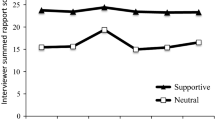Abstract
The current study examined the nature and style of mother-adolescent conversations, how these conversations differ by subject matter, and dyadic and individual differences. Thirty-one mother-adolescent dyads (17 boys, 14 girls) with a child between the ages of 11 and 14 had a nonstructured conversation, and conversations about conflict and sexuality. They also completed questionnaires on beliefs about acquired immunodeficiency syndrome (AIDS). Conversations were measured for turn taking, total number of words, and conversational dominance, as well as nonverbal measures of affiliation, shame, and contempt. Conversations about sexuality involved less turn taking, fewer words, and more mother dominance than nonstructured conversations. Conversations about conflicts involved less turn taking but more words than nonstructured conversations. Some gender and age differences were found. More interactive conflict conversations contained higher levels of affiliation, and lower levels of child shame than conversations with fewer turns or higher mother dominance. In addition, children in more interactive dyads possessed a larger percentage of their mother's AIDS knowledge, and worried about AIDS a moderate amount.
Similar content being viewed by others
References
Adams, G. R., Abraham, K. G., and Markstrom, C. A. (1987). The relations among identity development, self-consciousness, and self-focusing during middle and late adolescence.Develop. Psychol. 23: 292–297.
Alexander, J. F. (1973). Defensive and supportive communications in family systems.J. Marriage Family 70: 613–617.
Baldwin, S. E., and Baranoski, M. V. (1990). Family interactions and sex education in the home.Adolescence 25: 573–345.
Bandura, A. (1964). The stormy decade: Fact or fiction?Psychol. Schools 1: 224–231.
Cooper, C. R., and Carlson, C. (1988). Individuality and connectedness in family relationships during early adolescence: Gender differences and predictors of self esteem. Presented at the meetings of the Society for Research in Adolescence, Alexandria, VA.
Cotterell, J. L. (1992). The relation of attachments and support to adolescent well-being and school adjustment.J. Adoles. Res. 7: 28–42.
Emmons, C. A., Joseph, J. G., Kessler, R. C., Wortman, C. B., Montgomery, S. B., and Ostrow, D. G. (1986). Psychosocial predictors of reported behavioral change in homosexual males at risk for AIDS.Health Educat. Quart. 13: 331–345.
Fisher, T D. (1991). Characteristics of mothers and fathers who talk to their adolescent children about sexuality.J. Psychol. Human Sexual. 3: 53–70.
Fox, G. L., and Inazu, J. K. (1980). Patterns and outcomes of mother-daughter communication about sexuality.J. Social Issues 36: 7–27.
Furstenberg, F. F., Herceg-Baron, R., Shea, J., and Webb, D. (1984). Family communication and teenagers' contraceptive use.Family Plan. Perspect. 16: 163–170.
Gibbs, N. (1993, May 24). How should we teach our children about sex?Time, pp. 60–66.
Greenberg, M. T., Siegel, J. M., and Leitch, C. J. (1983). The nature and importance of attachment relationships to parents and peers during adolescence.J. Youth Adolesc. 12: 373–386.
Grotevant, H. D., and Cooper, C. R. (1985). Patterns of interaction in family relationships and the development of identity exploration in adolescence.Child Develop. 56: 415–428.
Hauser, S. T., Houlihan, J., Powers, S. I., Jacobson, A. M., Noam, G. G., Weiss-Perry, B., Follansbee, D., and Book, B. K. (1991). Adolescent ego development within the family: Family styles and family sequences.Int. J. Behav. Develop. 14: 165–193.
Hill, J. R., and Holmbeck, G. (1986). Attachment and autonomy during adolescence: In Whitehurst, G., (ed.),Annals of Child Development. JAI Press, Greenwich, CT.
Jacob, T. (1974). Patterns of family conflict and dominance as a function of child age and social class.Develop. Psychol. 10: 1–12.
Kahlbaugh, P. E., and Haviland, J. M. (1994). Nonverbal communication between parents and adolescents: A study of approach and avoidance behaviors.J. Nonverb. Behav. 18: 91–113.
Kahlbaugh, P. E., Lefkowitz, E. S., and Sigman, M. D. (submitted). The affective nature of mother-adolescent communication concerning sexuality and conflict. Manuscript.
Kenny, M. E. (1987). The extent and function of parental attachment among first-year college students.J. Youth Adolesc. 16: 17–29.
Montemayor, R. (1983). Parents and adolescents in conflict: All families some of the time and some families most of the time.J. Early Adoles. 3: 83–103.
Moore, K. A., Peterson, J. L., and Furstenberg, F. F. (1986). Parental attitudes and the occurrence of early sexual activity.J. Marriage Family 48: 777–782.
National Commission on AIDS. (1993).Behavioral and Social Sciences and the HIV/AIDS Epidemic. Washington, DC.
O'Connell, D. C., Kowal, S., and Kaltenbacher, E. (1990). Turn-taking: A critical analysis of the research tradition.J. Psycholing. Res. 19: 345–373.
Papini, D. R., Farmer, F. F., Clark, S. M., Micka, L. C., and Barnett, J. K. (1990). Early adolescent age and gender differences in patterns of emotional self-disclosure to parents and friends.Adolescence 25: 959–975.
Petersen, A. C. (1988). Adolescent development.Ann. Rev. Psychol. 39: 583–607.
Steinberg, L. D. (1981). Transformations in family relations at puberty.Develop. Psychol. 17: 833–840.
Tucker, S. K. (1989). Adolescent patterns of communication about sexually related topics.Adolescence 25: 269–278.
Zimet, G. D., Hillier, S. A., Anglin, T M., Ellick, E. M., Krowchuk, D. P., and Williams, P. (1991). Knowing someone with AIDS: The impact on adolescents.J. Pediat. Psychol. 16: 387–394.
Author information
Authors and Affiliations
Additional information
This research was supported by National Institutes of Child Health and Human Development Grant No. HD27035.
Received M.A. from UCLA. Current research interests include parent-adolescent relationships, adolescent peer relations, and adolescent sexuality.
Received Ph.D. from Rutgers, The State University of New Jersey. Major research interest is in parent-adolescent communication and emotional development.
Received Ph.D. from Boston University. Major research interest is in parent-child affective communication.
Rights and permissions
About this article
Cite this article
Lefkowitz, E.S., Kahlbaugh, P.E. & Sigman, M.D. Turn-taking in mother-adolescent conversations about sexuality and conflict. J Youth Adolescence 25, 307–321 (1996). https://doi.org/10.1007/BF01537387
Received:
Accepted:
Issue Date:
DOI: https://doi.org/10.1007/BF01537387




